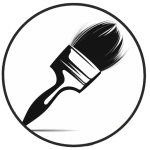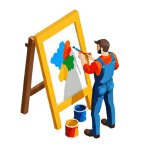Welcome to the Self-Guided Online Lesson: How to Paint
Understanding the Importance of Painting Tools
Welcome, painters! In this self-guided online lesson, we will explore the fascinating world of painting and learn step-by-step techniques to create beautiful works of art. One of the essential aspects of painting is utilizing the right tools to bring your artistic vision to life. From brushes and palettes to easels and canvases, the tools you use can greatly impact the final outcome of your masterpiece.
By understanding the importance of painting tools and how to use them effectively, you will enhance your skills and unleash your creativity. Whether you are a beginner looking to learn the basics or an experienced artist seeking to refine your techniques, mastering the use of painting tools is crucial for every painter.
Join us on this exciting journey as we delve into the world of painting tools and discover how they can elevate your artwork to new heights. Let's begin!
Before you begin your painting project, it's essential to familiarize yourself with the necessary tools that will help you achieve a professional finish. Here are some of the essential painting tools that every painter should have:
1. Paintbrushes: Invest in a variety of high-quality paintbrushes in different sizes and shapes to tackle different areas and details of your painting project.
2. Paint Rollers: Paint rollers are excellent for covering large surface areas quickly and efficiently. Make sure to choose the right nap length for the texture of the surface you are painting.
3. Paint Trays: Use paint trays to hold and distribute paint evenly onto your rollers. This will help you avoid drips and ensure a consistent application.
4. Painter's Tape: Painter's tape is essential for creating clean lines and protecting surfaces that you don't want to paint. Make sure to apply it carefully and remove it promptly after painting.
5. Drop Cloths: Protect your floors and furniture from paint splatters and spills by using drop cloths or plastic sheeting. This will make cleanup much easier and prevent damage to your belongings.
6. Sandpaper: Sandpaper is handy for smoothing out rough surfaces, removing old paint, and preparing surfaces for painting. Make sure to use the appropriate grit for the task at hand.
7. Paint Trays: A sturdy ladder or step stool will help you reach high or awkward areas safely while painting. Make sure it is stable and secure before climbing up.
Having these essential painting tools at your disposal will make your painting project more manageable and enjoyable. Make sure to keep them clean and in good condition for future use.
When it comes to painting, it's essential to understand the function of each tool you use. By knowing how each tool contributes to the painting process, you can achieve better results and work more efficiently.
Brushes are one of the most crucial painting tools. They come in various shapes and sizes, each serving a specific purpose. Flat brushes are excellent for covering large areas, while round brushes are ideal for adding details. Understanding the different types of brushes and their uses will help you achieve the desired effects in your paintings.
Palette knives are another essential tool for painters. They are versatile instruments that can be used for mixing colors, applying paint in a textured manner, and creating unique effects. Experimenting with palette knives can add depth and interest to your paintings.
Painting rollers are commonly used for painting large surfaces quickly and efficiently. They are particularly useful for walls, ceilings, and other expansive areas. Understanding how to use a painting roller correctly can help you achieve a smooth and even finish.
A paint sprayer is a more advanced tool that can be used to apply paint evenly over large areas. It is essential to understand how to control the spray pattern and pressure to achieve the desired results. While paint sprayers can speed up the painting process, they require practice to master.
Proper maintenance and care of your painting tools are essential to ensure they last long and perform optimally. Follow these tips to keep your tools in top condition:
1. Clean your tools after each use: Thoroughly clean brushes, rollers, and other tools with the appropriate cleaner immediately after use. This prevents paint from drying and hardening on the tools, making them difficult to clean later.
2. Store tools properly: Store brushes upright or hanging to maintain their shape. Keep rollers in a plastic bag to prevent them from drying out. Proper storage helps prevent damage and extends the life of your tools.
3. Replace damaged tools: Inspect your tools regularly for any signs of wear or damage. Cracked brushes, bent rollers, or broken handles should be replaced to ensure smooth and efficient painting.
4. Use the right tools for the job: Using the correct tools for different painting tasks not only ensures a better finish but also prevents unnecessary wear and tear on your tools. Choose the appropriate brush size and type of roller for the surface you are painting.
Organizing your painting tools is essential to maintaining an efficient workflow and improving the overall quality of your work. Here are some tips to help you organize your tools effectively:
1. Create a designated workspace for your painting tools. Having a specific area where you keep all your tools will help you easily locate them when you need them.
2. Use storage containers or toolboxes to keep your tools organized. Sort your brushes, paints, rollers, and other tools into separate containers to prevent clutter and confusion.
3. Label your storage containers to quickly identify the contents inside. This will save you time searching for specific tools and materials during your painting project.
4. Keep frequently used tools within arm's reach. Place these tools in a convenient location to eliminate the need to constantly search for them while working.
5. Establish a routine for organizing and cleaning your tools after each painting session. This practice will help you maintain the condition of your tools and prevent any unnecessary delays during future projects.
By following these organization tips, you can create a more efficient workflow and enhance your painting experience. Take the time to set up your painting tools properly, and you'll see a significant improvement in your productivity and the quality of your work.
Practice Exercises:
1. Brush Strokes: Begin by practicing different types of brush strokes using various brushes. Experiment with strokes such as the flat brush stroke, round brush stroke, and fan brush stroke. This will help you gain control and precision in your painting.
2. Color Mixing: Practice mixing different colors to create new shades and tones. Start with primary colors and gradually work your way to mixing more complex hues. Understanding color theory and how colors interact will enhance your painting skills.
3. Still Life Studies: Set up a simple still life arrangement and practice painting it. Focus on capturing the light and shadows, textures, and proportions. This exercise will improve your observation skills and help you develop a keen eye for detail.
Tool Selection Tips:
1. Choose the Right Brush: Selecting the appropriate brush for the task is crucial. Different brushes are designed for specific techniques and effects. For example, use a stiff bristle brush for textured areas and a soft sable brush for smooth blending.
2. Quality Over Quantity: Invest in high-quality painting tools, such as brushes, canvas, and paints. While it may be tempting to opt for cheaper supplies, quality tools will produce better results and make the painting process smoother.
3. Experiment with Different Tools: Don't limit yourself to just one type of tool. Try using palette knives, sponges, or even unconventional tools to create unique textures and effects in your paintings.
Painters: Achieving Efficient Workflow with Painting Tools
Bringing It All Together
As we conclude this lesson on painters and the importance of utilizing painting tools to achieve an efficient workflow, it is crucial to remember that the tools we use play a significant role in the quality and speed of our work. By selecting the right tools and mastering their use, we can streamline our painting process and produce better results in less time.
If you feel the need to revisit any part of this lesson or if you are looking to enhance your painting skills further, don't hesitate to review the content covered here. Remember, practice and continuous learning are key to becoming a proficient painter.
Make sure to explore the other lessons in this course to deepen your understanding of painting techniques and tools. Each lesson contributes to your growth as an artist and helps you refine your craft.
Lesson Audio

